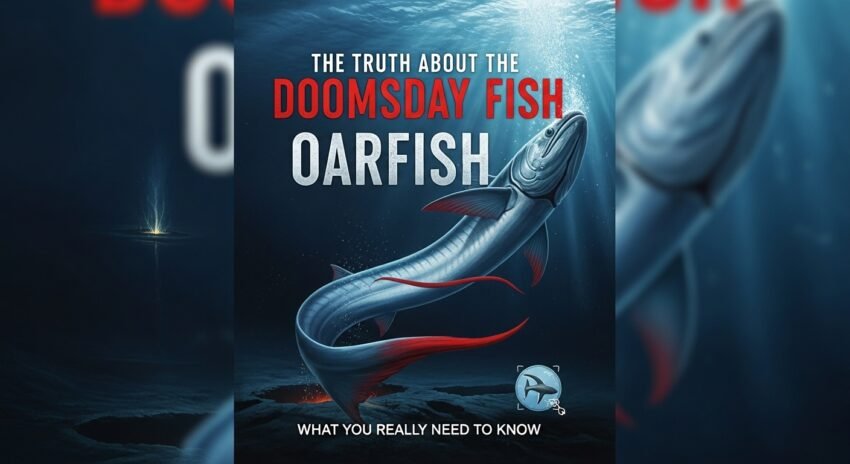Table of Contents
Have you ever heard of the “doomsday fish oarfish“? It sounds scary, right? Many people think this deep-sea creature is a sign that something terrible is about to happen—like an earthquake or tsunami. But is that true? Or is it just an old myth that has spread over time? Today, we’re diving deep into the fascinating world of the oarfish. We’ll uncover what it is, where it lives, and why it’s earned such an eerie nickname. Don’t worry—this article explains everything in a simple, friendly way. Even if you’re not a science lover, you’ll enjoy learning about one of the ocean’s most mysterious fish.
What Is the Doomsday Fish Oarfish?
The oarfish is one of the longest fish in the world. Some can grow over 30 feet long! That’s longer than a school bus. It has a shiny, silver ribbon-like body and a bright red fin across its back and head that makes it look like something from a fantasy movie. Because of this strange look, it’s sometimes called a sea serpent. It lives very deep in the ocean where it’s super dark and cold. People don’t see it often, which makes it even more mysterious. But when an oarfish washes up on shore, it grabs lots of attention—and sometimes fear.
Why Is It Called the “Doomsday Fish”?
In some places like Japan, people think the oarfish is a warning sign. That’s how it got the nickname “doomsday fish oarfish.” In the past, some big earthquakes happened shortly after oarfish were found near land. Because of this, a legend began that said oarfish swim up from deep water to deliver a message: danger is coming. Scientists have tried to prove or disprove this idea, but there’s no solid proof. Still, as more people spot them, the nickname continues. The name may be spooky, but it adds to the deep-sea mystery.
Can Oarfish Predict Earthquakes?
This is a big question people want answered. Can the doomsday fish oarfish really feel or sense earthquakes before they happen? Some researchers believe that fish living deep in the ocean might be able to sense small shifts or changes in the Earth’s crust. But no study has confirmed this yet. Others think these fish come to the surface because they are sick—not because something dangerous is coming. The Earthquake Research Institute in Japan even said there’s no proven link. So, for now, it remains just an interesting guess, not a scientific fact.
What Do Oarfish Look Like?
Imagine seeing a super long, shiny ribbon floating in the sea. That’s kind of what an oarfish looks like. Its body is long and thin with soft, silver skin and a red fin that stands tall across its back, almost like a crown or feathered mane. It doesn’t have typical fish scales, and its eyes are large to help it see in dark waters. Its mouth is small because it doesn’t need to bite or hunt big prey. Its other fins are small but help it float and wave gently through the ocean like a slow-moving flag.
Where Do Oarfish Live?
The doomsday fish oarfish lives deep in the ocean—so deep that sunlight can’t reach it. Most oarfish are found between 600 and 3,000 feet underwater. That’s far below where people swim or where regular fish live. They prefer the cold, calm, dark sea. You can find oarfish in oceans all over the world. They’ve been seen near Japan, the United States, Chile, and even near islands in the Pacific. But because they live so deep, people usually only see them when something’s wrong—like if they’re injured or when currents push them closer to shore.
What Do Oarfish Eat?

Even though oarfish are big, their meals are super tiny. This giant fish eats small animals like plankton, krill, and jellyfish. Instead of chasing after food, they open their mouths wide and let water—and food—flow in. They use small bones in their mouth to trap the food. This feeding style is called filter feeding. Unlike sharks or other predators, oarfish don’t hunt, bite, or use speed. They are slow and peaceful diners drifting through the dark sea, collecting snacks with the water as it moves around them.
How Do Oarfish Swim?
Oarfish swim very differently from most fish. They wave one long fin that runs across their back. This makes them move gently through the water like a ribbon caught in the breeze. What’s even stranger is that they sometimes swim upright, with their head pointed straight up and tail pointing down. Scientists believe this upright swimming helps them spot food floating above or helps them avoid trouble. Because they live so deep, we haven’t had many chances to see them swim in their natural environment. Still, they move slowly and with grace—never quickly or harshly.
Why Do Oarfish Come to Shore?
Most of the time, oarfish stay deep in the sea where people can’t see them. But when an oarfish is weak, sick, or close to dying, it may float up to the surface. Ocean currents, storms, temperature changes, or pollution can confuse or hurt them. That’s why people sometimes find these creatures near the shore or washed up on beaches. These rare events surprise locals, and rumors start to spread. Some think trouble is coming, while others just wonder, “What is this strange fish?” It’s not a sign of doom—just a reminder of how mysterious nature can be.
Are Oarfish Dangerous to People?
Not at all! The doomsday fish oarfish might look spooky, but it’s completely harmless to people. It doesn’t have teeth sharp enough to bite or a mouth big enough to hurt someone. It doesn’t attack. In fact, oarfish are very shy and gentle. They don’t chase anything. If you saw one swimming, it would probably ignore you or try to swim away. Many people who have seen one in the water say it feels like meeting a creature from another world, quiet and peaceful. If you ever see one, count yourself lucky—it’s a rare and beautiful thing.
10 Fun Facts About the Doomsday Fish Oarfish
- It’s the longest bony fish in the world.
- Some grow longer than 35 feet!
- The oarfish got its name because it looks like a giant boat oar.
- Japanese legends call it “Messenger from the Sea God’s Palace.”
- It swims straight up and down instead of sideways.
- It doesn’t have normal fish scales—its skin is smooth and shiny.
- Oarfish can live in very deep water, over half a mile below the surface.
- They only come up when they’re sick or confused.
- Some experts think they feel underwater movements before earthquakes.
- Most people have never seen a live oarfish in the wild.
Can Oarfish Teach Us About the Deep Sea?
Yes! Since oarfish live in parts of the ocean where very few creatures go, they can help scientists learn about deep-sea life. If we study oarfish more, we might understand how they survive in freezing, dark places. We can also learn how ocean currents or climate changes affect sea animals. For example, if oarfish are coming up more often, it might mean something is changing deep underwater. They’re like messengers—but maybe not of doom. Maybe they’re trying to tell us about our planet and its oceans instead.
What Should You Do if You See an Oarfish?
First, don’t panic! The doomsday fish oarfish is not a danger to you. If it’s alive, don’t touch it. These fish are delicate and likely already stressed. You can call your local marine rescue team or wildlife group to report it. If it’s dead, scientists might want to study its body to learn more. Take photos from a safe distance and share them with researchers, not just social media. Seeing an oarfish can be an exciting, rare chance to help science. It’s a great chance to turn a mystery into something meaningful.
Frequently Asked Questions (FAQs)
What is a doomsday fish oarfish?
The doomsday fish oarfish is a deep-sea fish best known for its long ribbon-like body and its link to earthquake myths. It’s harmless but often seen as a mystery because it’s rarely spotted.
Is the oarfish linked to earthquakes?
There’s no solid science proving oarfish can predict earthquakes, though some people believe they sense changes underwater before a disaster.
Where do oarfish live?
Oarfish live deep in oceans around the world—up to 3,000 feet underwater. They usually stay far from the shore.
Are oarfish dangerous to humans?
No, oarfish are not dangerous at all. They don’t attack or bite and are very gentle.
What do oarfish eat?
They eat tiny animals like plankton and krill. They don’t hunt. Instead, they float and filter small food from the water.
Why do oarfish come to the surface?
When oarfish come to the surface, they’re usually sick, dying, or confused by ocean currents. It’s rare and not usually a sign of danger.
Final ThoughtsOarfish?
The doomsday fish oarfish may look spooky and strange, but it’s really just another wonder from our amazing ocean. Its name comes from fear and legend, not fact. Instead of worrying when we see one, let’s take the moment to learn. These deep-sea creatures have secrets that scientists are still discovering. They can teach us about the ocean, climate, and maybe even Earth itself. So the next time the word “doomsday fish oarfish” shows up in the news, don’t be scared—be curious. And if you loved learning about this sea mystery, share the story with your friends and family. Let’s keep the wonder of the ocean alive together!
